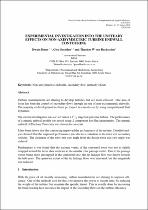 ResearchSpace
ResearchSpace
Experimental investigation into the unsteady effects on non-axisymmetric turbine endwall contouring
JavaScript is disabled for your browser. Some features of this site may not work without it.
- ResearchSpace
- →
- Research Publications/Outputs
- →
- Conference Publications
- →
- View Item
| dc.contributor.author |
Dunn, Dwain I

|
|
| dc.contributor.author |
Snedden, Glen C

|
|
| dc.contributor.author |
Von Backström, TW

|
|
| dc.date.accessioned | 2010-02-04T07:19:52Z | |
| dc.date.available | 2010-02-04T07:19:52Z | |
| dc.date.issued | 2010-01 | |
| dc.identifier.citation | Dunn, D, Snedden, GC and Von Backström, TW. 2010. Experimental investigation into the unsteady effects on non-axisymmetric turbine endwall contouring. 7th South African Conference on Computational and Applied Mechanics (SACAM10). Pretoria, 10-13 January 2010, pp 1-11 | en |
| dc.identifier.uri | http://hdl.handle.net/10204/3927 | |
| dc.description | 7th South African Conference on Computational and Applied Mechanics (SACAM10). Pretoria, 10-13 January 2010 | en |
| dc.description.abstract | Turbine manufacturers are striving to develop turbines that are more efficient. One area of focus has been the control of secondary flows through the use of non-axisymmetric endwalls. The majority of development has been performed in cascades or by using computational fluid dynamics. The current investigation was carried out on a 1 1/2 stage low pressure turbine. The performance of a generic endwall profile was tested using 2 component hot-film anemometry. The generic endwall of Durham University was chosen for analysis It has been shown that the contouring improved the performance of the turbine. Detailed analysis showed that the improved performance was due to a reduction in the rotor exit secondary velocity. The deviation of the rotor exit yaw angle from the design rotor exit yaw angle was reduced. Furthermore it was found that the passage vortex of the contoured rotor was not as tightly wrapped around the horse shoe vortices as the annular rotor passage vortex. Due to the passage vortex being more unwrapped in the contoured case, the tip leakage flow was drawn towards the hub more. The span wise extent of the tip leakage flows was increased, but the magnitude was reduced. | en |
| dc.language.iso | en | en |
| dc.publisher | South African Conference on Computational and Applied Mechanics | en |
| dc.subject | Unsteady effect | en |
| dc.subject | Non-axisymmetric endwall | en |
| dc.subject | Computational mechanics | en |
| dc.subject | Applied mechanics | en |
| dc.subject | Computational fluid dynamics | en |
| dc.subject | Generic endwall | en |
| dc.title | Experimental investigation into the unsteady effects on non-axisymmetric turbine endwall contouring | en |
| dc.type | Conference Presentation | en |
| dc.identifier.apacitation | Dunn, D. I., Snedden, G. C., & Von Backström, T. (2010). Experimental investigation into the unsteady effects on non-axisymmetric turbine endwall contouring. South African Conference on Computational and Applied Mechanics. http://hdl.handle.net/10204/3927 | en_ZA |
| dc.identifier.chicagocitation | Dunn, Dwain I, Glen C Snedden, and TW Von Backström. "Experimental investigation into the unsteady effects on non-axisymmetric turbine endwall contouring." (2010): http://hdl.handle.net/10204/3927 | en_ZA |
| dc.identifier.vancouvercitation | Dunn DI, Snedden GC, Von Backström T, Experimental investigation into the unsteady effects on non-axisymmetric turbine endwall contouring; South African Conference on Computational and Applied Mechanics; 2010. http://hdl.handle.net/10204/3927 . | en_ZA |
| dc.identifier.ris | TY - Conference Presentation AU - Dunn, Dwain I AU - Snedden, Glen C AU - Von Backström, TW AB - Turbine manufacturers are striving to develop turbines that are more efficient. One area of focus has been the control of secondary flows through the use of non-axisymmetric endwalls. The majority of development has been performed in cascades or by using computational fluid dynamics. The current investigation was carried out on a 1 1/2 stage low pressure turbine. The performance of a generic endwall profile was tested using 2 component hot-film anemometry. The generic endwall of Durham University was chosen for analysis It has been shown that the contouring improved the performance of the turbine. Detailed analysis showed that the improved performance was due to a reduction in the rotor exit secondary velocity. The deviation of the rotor exit yaw angle from the design rotor exit yaw angle was reduced. Furthermore it was found that the passage vortex of the contoured rotor was not as tightly wrapped around the horse shoe vortices as the annular rotor passage vortex. Due to the passage vortex being more unwrapped in the contoured case, the tip leakage flow was drawn towards the hub more. The span wise extent of the tip leakage flows was increased, but the magnitude was reduced. DA - 2010-01 DB - ResearchSpace DP - CSIR KW - Unsteady effect KW - Non-axisymmetric endwall KW - Computational mechanics KW - Applied mechanics KW - Computational fluid dynamics KW - Generic endwall LK - https://researchspace.csir.co.za PY - 2010 T1 - Experimental investigation into the unsteady effects on non-axisymmetric turbine endwall contouring TI - Experimental investigation into the unsteady effects on non-axisymmetric turbine endwall contouring UR - http://hdl.handle.net/10204/3927 ER - | en_ZA |





